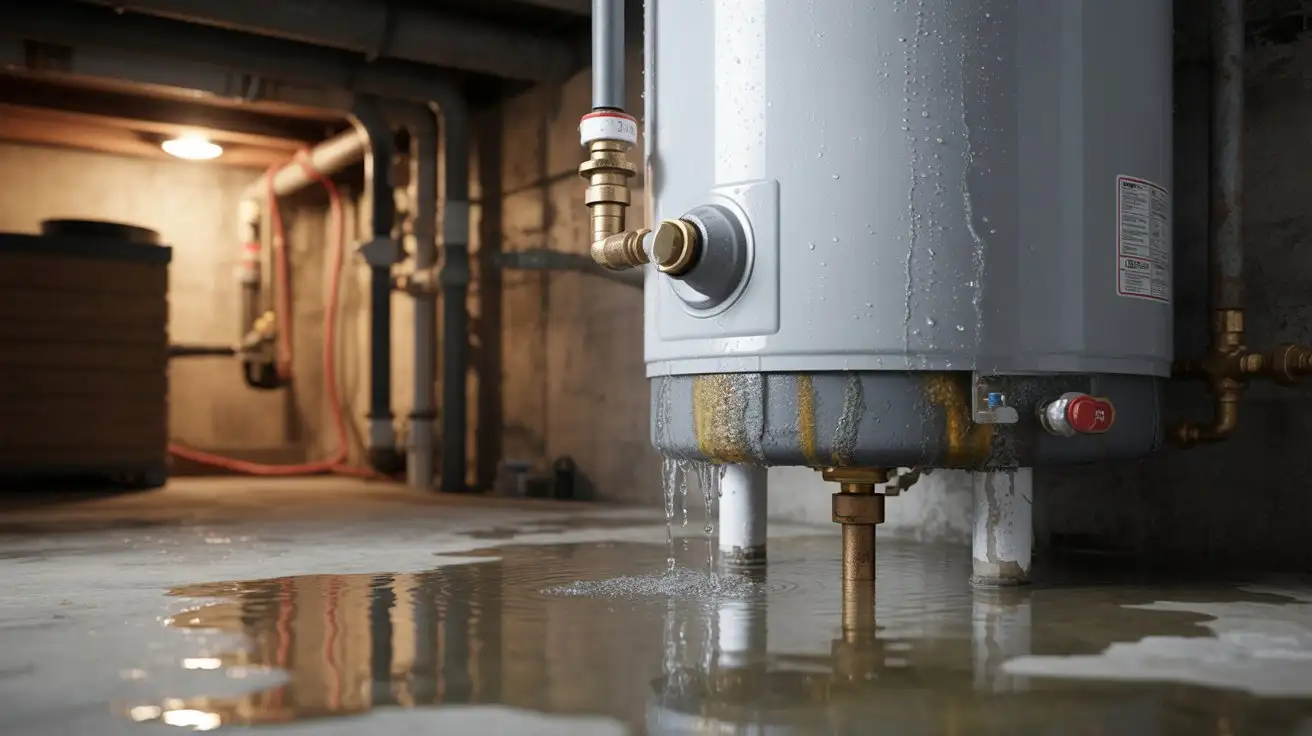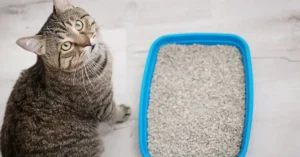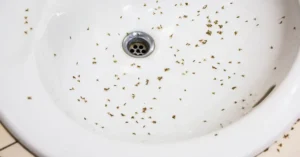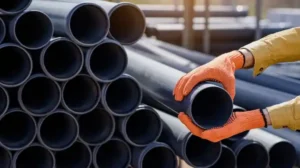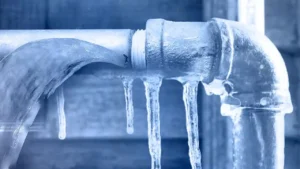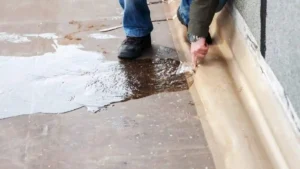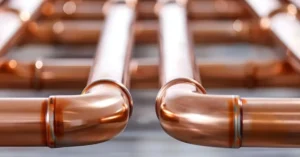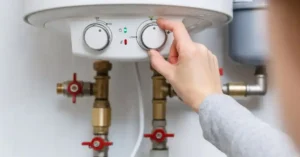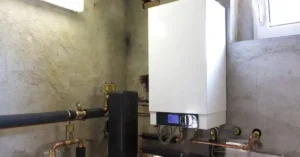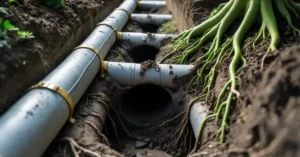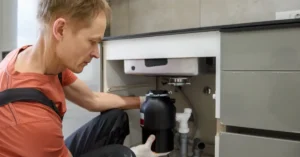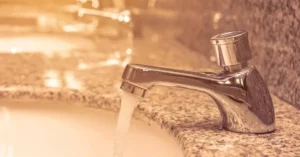A puddle around your hot water heater is never a good sign it often signals trouble that can lead to costly repairs or loss of hot water. If you’re asking yourself why is my water heater leaking, the cause is usually a faulty valve, loose pipe connection, or a corroded tank. Over time, wear and tear or mineral buildup can damage internal components, allowing water to escape. Identifying the source of the leak quickly is crucial to prevent water damage and higher repair costs. Whether it’s a small drip or a major leak, addressing the problem early ensures your system runs safely and efficiently.
What Causes Water Heater Leaks?
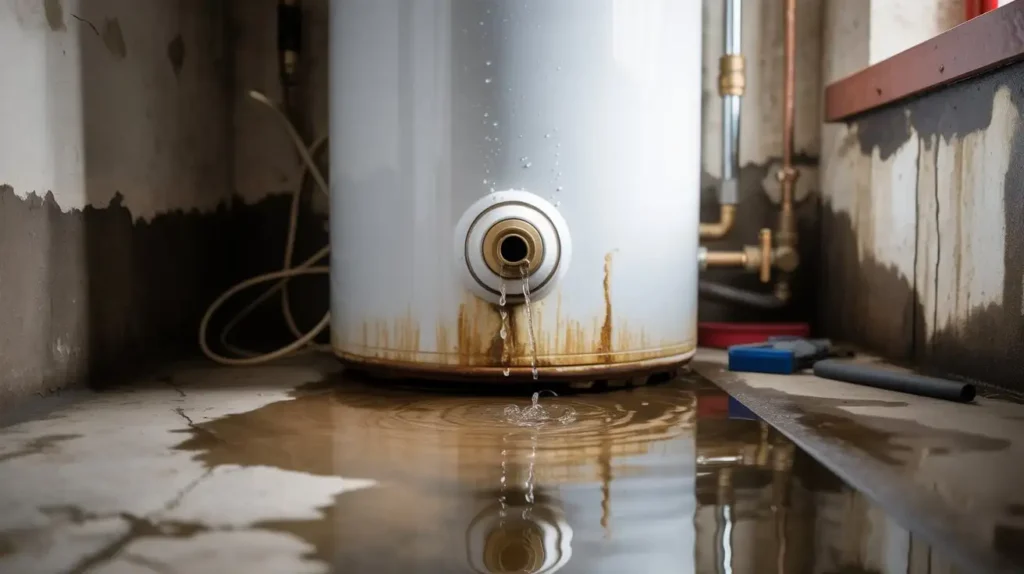
Understanding the cause of your leaking water heater helps you figure out the best course of action. Water heaters contain several parts that handle water pressure, heat, and flow, and over time, any of them can fail.
Age and Corrosion
Water heaters typically last 8-12 years. Over time, sediment builds up inside the tank. This sediment speeds up corrosion, which eats through the metal and creates holes. If your unit is over 10 years old and leaking, age is likely the main issue.
Faulty Pressure Relief Valve
The pressure relief valve is a safety device that releases pressure when it gets too high inside the tank. A faulty valve can leak water or fail to work properly. Sometimes mineral deposits clog the valve, causing it to drip constantly.
Loose Drain Valve
The drain valve sits near the bottom of your tank. It’s used to flush sediment during maintenance. If this valve isn’t tight or the washer inside wears out, you’ll notice leaking water pooling below your heater.
Cracked or Damaged Tank
The inner tank can crack from corrosion or manufacturing defects. When the tank itself is damaged, water seeps through the outer shell. This type of water heater leak usually means you need a replacement.
High Water Pressure
Your home’s water supply pressure should stay between 50-80 PSI. When pressure climbs too high, it stresses your tank and valves. This extra pressure can cause leaks at weak points and shorten your heater’s life.
Loose or Damaged Inlet/Outlet Connections
Cold water enters through the inlet pipe, and hot water exits through the outlet. These connections can loosen over time or develop worn washers. Either problem creates a water heater leak at the top of the unit.
Temperature Settings Too High
Setting your thermostat above 130°F creates excessive pressure inside the tank. This pressure forces water out through the pressure relief valve. It also accelerates corrosion and wastes energy.
Signs Your Water Heater Is Leaking
It is important to catch a leak early to prevent serious water damage. The signs of a hot water heater is leaking are often quite noticeable.
Visible Water Pooling
Check around your water heater regularly. Any puddles, moisture, or damp spots mean you have a leak. Even small amounts of water signal a problem that needs attention.
Rust-Colored Water
Brown or rust-colored water from your hot taps indicates corrosion inside your tank. This rust often comes with leaks or will lead to them soon.
Strange Noises
Popping, banging, or rumbling sounds point to sediment buildup. This sediment traps water underneath, which boils and causes noise. The same sediment that makes noise also causes leaks.
Reduced Hot Water Supply
A heater leaking slowly loses water volume. You might notice shorter showers or running out of hot water faster than normal.
Higher Water Bills
Unexplained increases in your water bill can mean your water heater is leaking. Even small drips waste hundreds of gallons over time.
Moisture on Tank Surface
Run your hand along the tank’s sides. Any dampness, even without visible puddles, means water is escaping somewhere.
What Do Water Heater Leaks from Top, Bottom, or Side Mean?
The location of the drip gives you a major clue about why my water heater leaking and the severity of the problem.
Leaks from the Top
Top leaks usually come from loose inlet or outlet connections. These pipes bring cold water in and send hot water out. The connections can work loose or the washers can fail. You might also see leaks from the temperature and pressure relief valve mounted near the top.These leaks are typically easier to fix. Tighten the connections or replace worn washers. If the pressure relief valve leaks constantly, you may need a new valve or have a pressure problem.
Leaks from the Bottom
Bottom leaks often signal more serious issues. The drain valve might be loose or damaged. Sediment buildup at the tank bottom can cause corrosion and tiny holes. In worse cases, the tank itself has rusted through.Drain valve problems are fixable. Tank corrosion at the bottom usually means replacement time.
Leaks from the Side
Side leaks are less common but concerning. They typically indicate tank corrosion or a crack in the tank wall. When you see water seeping from the side, the inner tank has likely failed. This damage can’t be repaired you’ll need a new water heater.
How to Fix a Leaking Water Heater
Safety comes first. Turn off the power (circuit breaker for electric, gas valve for gas units) before working on your heater.
Step 1: Identify the Leak Source
Dry the area completely. Watch carefully to see exactly where water appears first. Use a flashlight to check all connections, valves, and the tank surface.
Step 2: Fix Common Problems
For loose connections: Turn off the water supply. Use a pipe wrench to carefully tighten inlet and outlet connections. Don’t overtighten you can crack the fittings.
For drain valve leaks: Try tightening the valve first. If it still leaks, replace it. Most drain valves are inexpensive and easy to swap out.
For pressure relief valve issues: Test the valve by lifting the lever. Water should flow and stop cleanly. If the valve drips constantly or won’t seal, replace it. This is a $15-30 part that takes 20 minutes to change.
Step 3: Reduce Water Pressure
Install a pressure-reducing valve on your main water supply line if pressure exceeds 80 PSI. Test your pressure with a gauge from any hardware store.
Step 4: Drain and Flush the Tank
Sediment causes many problems. Drain several gallons through the drain valve every six months. This removes sediment before it causes damage.
Step 5: Lower Temperature Setting
Set your thermostat to 120°F. This temperature is hot enough for all household needs while reducing pressure and slowing corrosion.
How to Prevent Water Heater Leaks
Proactive maintenance is the best way to prevent your heater leaking and extend the life of your unit.
Annual Professional Inspection
Have a licensed plumber check your water heater yearly. They’ll spot small problems before they become big leaks. This inspection typically costs $100-150 and includes testing the pressure relief valve and checking the anode rod.
Regular Flushing
Drain 2-3 gallons from your tank every few months. This simple task removes sediment that causes corrosion. Set a phone reminder so you don’t forget.
Replace the Anode Rod
The anode rod is a metal rod inside your tank that attracts corrosive elements. It protects the tank by corroding instead of the tank walls. Replace it every 3-5 years to extend your heater’s life.
Monitor Water Pressure
Check your home’s water pressure twice a year. Keep it between 50-80 PSI. Install a pressure gauge on an outdoor faucet for easy testing.
Install a Drain Pan
Place a drain pan under your water heater with a drain line running to a floor drain or outside. This pan catches leaks before they damage your floor.
Maintain Proper Temperature
Keep your thermostat at 120°F. Higher temperatures create more pressure and accelerate wear on your tank and components.
Check for Recalls
Manufacturers occasionally recall water heaters for defects. Register your unit and check the manufacturer’s website yearly for recall notices.
When to Repair or Replace Your Water Heater
Not every leak means you need a new heater. Use these guidelines to decide:
Repair When:
- Your unit is less than 6 years old
- The leak comes from valves or connections
- Repair costs less than 50% of replacement cost
- Only one component has failed
- The tank shows no signs of corrosion
Replace When:
- Your heater is over 10 years old
- You see rust in your hot water
- The tank itself is leaking or cracked
- Multiple parts have failed
- Repairs cost more than half the replacement price
- You need frequent repairs
A new water heater costs $800-2,500 installed, depending on type and size. Gas and electric models are available in various capacities. Tankless units cost more upfront but last longer and save on energy bills.
Consider upgrading to a more efficient model when replacing. New heaters use less energy and often qualify for rebates or tax credits.
You can read about: Do Tankless Water Heaters Need Recirculation Pumps?
Where to Go for Water Heater Repairs and Services?
Choosing the right plumber for your water heater can make all the difference. Look for a licensed professional with years of experience who understands various types of water heaters. Check online reviews and select companies that offer transparent pricing and reliable emergency services. For homeowners in the Los Angeles area, Derks Plumbing offers expert Water Heater Installation Eagle Rock. Our skilled team can handle everything from small leak repairs to complete system replacements.Don’t delay when you notice a leak quick action helps prevent water damage and ensures your home stays comfortable. With professional plumbers, you get accurate diagnostics and lasting repairs done right the first time.
Conclusion
Discovering your water heater leaking demands immediate action. While a loose pipe connection or a simple faulty valve often allows for an easy repair, a leak from the main storage tank signals a complete failure of the unit. This major issue means you need an immediate replacement. The key to avoiding this stressful situation and answering the question, “Why is my water heater leaking” with a less costly answer is simple maintenance. Regular steps like flushing sediment and inspecting your components yearly will drastically reduce the risk of sudden, expensive damage. Do not ignore any sign of moisture; act fast to protect your home.
FAQs
Is a leaking water heater an emergency?
It depends on the leak size. Small drips can wait until business hours. Large leaks or active flooding need immediate attention. Turn off the water supply and power to prevent damage.
Can I use my water heater if it’s leaking?
You can temporarily use it if the leak is minor and from a valve. But schedule repairs quickly. Never use a heater with a leaking tank replace it immediately.
How much does it cost to fix a water heater leak?
Simple valve repairs cost $150-300. Pressure relief valve replacement runs $200-400. Major repairs or tank replacement costs $800-2,500. Get quotes from multiple plumbers.
Why is my water heater leaking from the bottom?
Bottom leaks usually mean a loose drain valve, sediment corrosion, or a cracked tank. Check the drain valve first it’s the easiest fix. If the tank is leaking, you need a replacement.
How long does a water heater last after it starts leaking?
This varies widely. Valve leaks can be fixed, and the heater might last years more. Tank leaks mean failure is imminent sometimes days, sometimes weeks. Don’t delay repairs.

